NECO CONCENTRICITY, WALL THICKNESS AND RUNOUT GAUGE
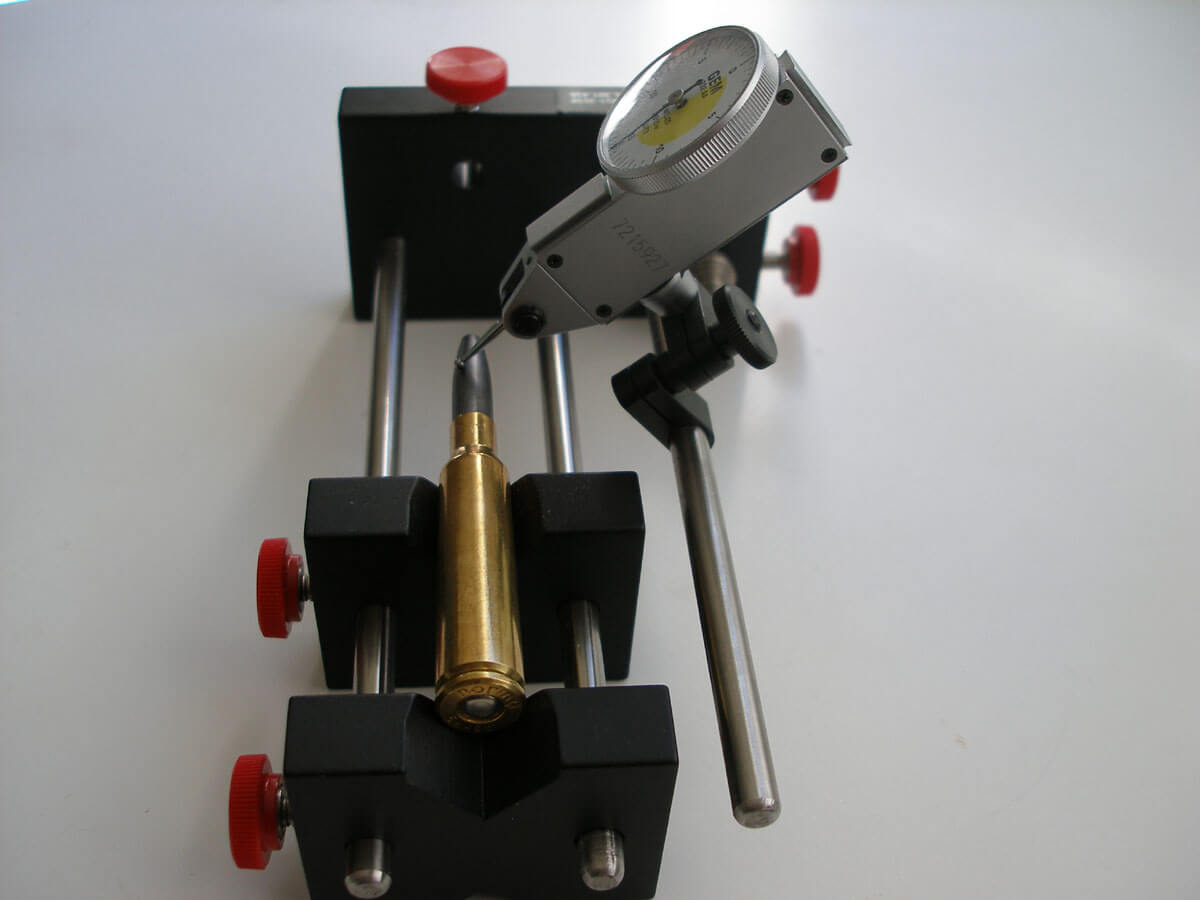
1) The curved “banana” shape of the cartridge case;
2) The relative wall thickness variation of a cartridge case;
3) The cartridge case head out-of-squareness;
4) Individual Bullets – out-of-round “egg shape” and/or
curved “banana” shape (excepting very small bullets);
5) The seated bullet and cartridge runout of loaded rounds. The accuracy of any firearm is determined — and limited — by the quality of the ammunition shot in it. The effect of imperfections in ammunition is cumulative; each flaw adds to the influence of all others. Precision shooters spend much time and effort “uniforming” cartridge cases, using advanced techniques to eliminate variation. Yet until recently, one of the most important of these variations has not been susceptible to detection by any device readily available to marksmen.
Normal manufacturing tolerances cause brass cartridge cases to vary in wall thickness around the circumference of their bodies. Under the stress of firing, a case with such variation stretches more readily along its thin side, transferring more pressure to the bolt face at that point and introducing an unbalanced force which contributes to bolt whip and vibration of the barreled action in its bedding. This whip and vibration varies from one shot to the next as cartridges are fired with their thin sides randomly oriented at different angles, causing reduced accuracy. The problem is made even worse if the brass is too hard or springy to completely fireform to the shape of the chamber, in which event the greater stretching of the case’s thin side will cause it to develop a curve along the length of its body. These “banana” cases cannot hold a bullet aligned with and centered in the bore, undercutting the effectiveness of the handloader’s careful case preparation.
Fortunately the accuracy problems caused by wall-thickness variation can be minimized, or perhaps eliminated, if all cases are “indexed” — fired with their thin sides always oriented the same direction in the chamber. This causes bolt whip to be minimized and consistent, and, while bullets will still be misaligned, they will all be misaligned the same way, which often produces accuracy like that of perfectly aligned and concentric ammunition.
All we need to index cases is a means of accurately locating each case’s thinnest point. This is not possible with traditional micrometers or other measuring devices used by handloaders.
The patented NECO Concentricity, Wall Thickness and Runout Gauge™ is a unique tool. In addition to permitting all the runout measurements possible with other concentricity checkers, it features a “chord anvil” fixture which allows the handloader to measure the wall thickness of cartridge cases, to determine its uniformity, and to precisely locate the thickest or thinnest point in each case. Brass can then be sorted according to uniformity, and permanently marked for indexing.
Until the advent of this new NECO gauge, indexing and checking for straightness procedures have been neglected because of the difficulty of the necessary measurements, but are now very easy to perform. Several large commercial ammunition manufacturers have adopted the NECO gauge as a standard laboratory tool for quality control purposes.
The NECO Concentricity, Wall Thickness and Runout Gauge™ is hand- assembled to precise tolerances from stainless-steel and hard-anodized aluminum components. It is equipped with a very high quality GEM Model #222A all-angle dial indicator and comes standard with two removable guides for bullet tips, two “step cones” for empty cases, a “chord anvil” for case-wall measurements, 2 double-sided V-blocks, convenient storage of accessories in the tool’s base, and a thorough Instruction Manual. This Instruction Manual explains in detail the “why and how” of cartridge-case-indexing and other desired operations.
The GEM 222A is an auto reversing test style dial indicator with a large easy to read face with .001 inch graduations and can be easily read to .0005 inch.
The Gauge will handle .22- to .50 BMG. cartridge cases,and an additional chord anvil to accommodate .50 Cal BMG cartridges. A .17 caliber chord anvil is available at a small extra cost.
NECO-COAT™ Bullet Moly Coating/Plating NECO-Coat™
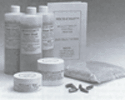
1) Decrease fouling;
2) Generally enhance accuracy;
3) Make cleaning easier;
4) Reduce friction;
5) Probably increase barrel life very significantly;
6) Probably reduce bullet drop–most notable at longer ranges with long bearing surface bullets;
7) Work perfectly with all types of bullets, including: hollow point, plastic tipped and lead or lead-tipped jacketed bullets;
8) Not be a “cure-all” for other firearm-related problems such as poor bedding, rough bores, etc.
The patented NECO-Coat™ Process (“Moly Coating/plating”) is a method of “impact plating” molybdenum disulfide (“moly,” MoS2) into the surface of cast or jacketed bullets, followed by an outer coating of carnauba wax. Molybdenum disulfide is one of the best dry sliding-friction lubricants in the world, and the purpose of NECO-Coat™ is of course to reduce friction between bullet and barrel bore. The entire process is accomplished with the use of a tumbler (a rotary tumbler is recommended, but a vibratory tumbler can be used with equal effectiveness), employing hardened (Rockwell C50), ground steel balls as an impact plating medium.
N
NECO Coat™ technology exploits one of molybdenum disulfide’s unique properties: when moly is driven against a metal surface, it forms a tight mechanical bond to the metal (it also has a natural affinity for metals), very much like plating of one metal on another. A jacketed bullet coated by the process has a “pretty”, shiny silver-metallic appearance and is not messy to handle. The coating is so thin that it cannot be reliably measured by ordinary calipers or micrometers, and it has no detrimental effect on the fit of bullets in the bore.
This process was originally developed simply to allow a greater number of accurate shots between cleanings by reducing bore fouling, and it performs this function extremely well. An unanticipated benefit is the improved accuracy which has been observed in many rifles and handguns firing coated bullets. Apparently the reduction in bore friction results in less barrel vibration and reduced distortion of bullets during firing.
Even more startling, testing of bullets coated by the NECO Process has, in many instances, shown what appears to be an increase in ballistic coefficient that gives improved flight characteristics at long range with rifle bullets. Competitive shooters have documented reductions in drop as large as five minutes of angle (5 MOA) at 1,000 yards with jacketed match bullets. Limited testing by a large ammunition manufacturer using advanced instrumentation showed a sometime increase in ballistic coefficient of at least three percent comparing coated to uncoated bullets from the same lot. It is believed this is mainly the result of bullets exiting the barrel more smoothly, allowing them to “go to sleep” (fly without oscillation) sooner.
While the fouling is always less, accuracy enhancement does vary with bullet type, cartridge, etc. There are no reports of a decrease in accuracy or of barrel damage from anyone.
By the end of 1997, the NECO-Coat™ Bullet moly coating/plating system had been well proven in serious competition, including winning national Benchrest matches, the Camp Perry national matches, while being used extensively by military marksmanship teams. Additionally, the process has found a strong following amongst varmint hunters as well as casual shooters.
The NECO-Coat™ Kit consists of the finest quality, laboratory-grade molybdenum disulfide (“Moly”) and powdered carnauba wax, hardened (Rockwell C50) and ground steel tumbling shot, ground corn cob, and an extremely thorough Instruction Manual. The materials in the kit are sufficient to coat at least 20,000 bullets, with 30-40,000 bullets more normal. Kit components are individually available to replenish supplies when necessary. The NECO Instruction Manual is not sold separately.
The NECO-Coat™ process has proven very effective when used on plain-base cast-lead bullets in conjunction with NECO P-Wads and Taurak™ bullet lubricant. This combination has produced exceptional performance in .45-70 Government rifles. In Schuetzen rifles it has yielded accuracy with fixed breech-loaded ammunition which is fully competitive with breech seated bullets.
The use of the moly coated bullets will also impregnate some molybdenum disulfide into the bore’s metal. This moly residue is not visible under 100+ power borescope magnification; the moly is actually within the crystalline structure of the metal, which we believe is exactly what it is supposed to do. This non-visible moly “residue” causes no problems and is perfectly normal and desired. The components of the NECO-Coat™ Kit are non-toxic and environmentally safe.
A SIEVE/STRAINER FOR NECO-COATING™
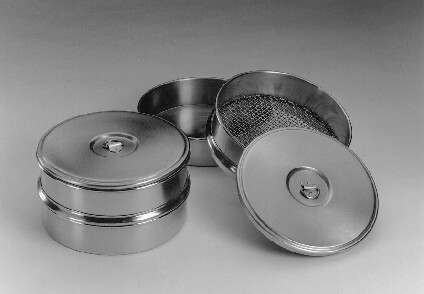
Pictured above is one of the finest sieves manufactured. The sieve is beautifully made of very thick brass with stainless steel mesh; it is two (2)
inches deep, eight (8) inches in diameter with a screen spacing of 0.187 inches (allowing our 5/32 inch balls to easily pass through, which will work fine for .22 caliber and larger).
Optional, and extremely effective, is a close fitting two (2) inch deep bottom catch pan and a “dust cover” for the top ….. both are made of very heavy, polished brass and appear to be a “work of art.” NECO is proud to make this sieve available and will stand behind it for quality and performance; this laboratory grade sieve is made to ASTM-E-11 Standards. Satisfaction guaranteed or money back.
TUMBLERS

NECO offers three tumblers for moly coating.
The Viking Rotary Tumbler is a top of the line, “first class,” commercial-grade lapidary tumbler which is designed to run thousands of hours with a minimum of attention (a unit in our shop has been in near-continous service for over 12 years)
MOLY-SLIDE Paste™
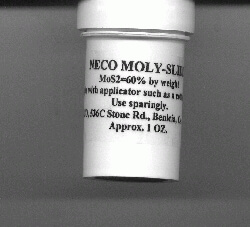
Moly-based pastes are used industrially for significantly reducing sliding friction in machinery, sliding bearings, and assembly to prevent galling and ease assembly/disassembly in close tolerance metallic components. These pastes also are superb for use in firearms in such places as the moving components on semi-auto pistols/rifles, pistol slides, bolt action components, most trigger components and firearm locking lugs. Mechanical performance is usually enhanced considerably, while the possibility of galling is minimized.
MOLY-SLIDE™ is a one (1) ounce plastic jar that contains approximately 60% laboratory-grade, extremely small, micron-sized Moly in paste form, formulated to have a consistency about like toothpaste. It has a very wide working temperature range with minimal evaporative loss. With careful use, a one ouncejar will usually last the average shooter/gunsmith or small machine shop for many, many years. A very little MOLY-SLIDE™ goes a very long way.
There is absolutely no graphite in NECO MOLY-SLIDE™.
Volume discounts are available.
CARTRIDGE CASE NECK DRY LUBRICATION KIT
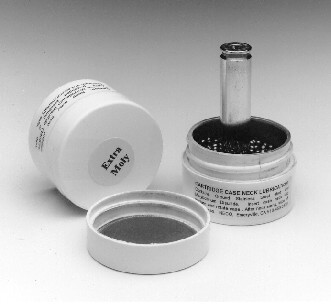
The Neck Lube Kit:
1) Will simply, easily and very rapidly lubricate both the inside and the outside of a cartridge case neck in one operation for neck sizing;
2) Is ideal for most manual neck turning operations;
3) Contains enough material in the “Deluxe” Kit to lubricate tens of thousands of cartridge cases;
4) Eliminates the need to clean neck lubricants from inside the case neck and will not decrease propellant or primer performance;
5) Is non-toxic and environmentally safe;
6) The “Deluxe” Kit uses ground, stainless steel balls for extremely long lasting corrosion resistance. Lead is not used for environmental and liability reasons and regular mild steels do rust;
7) Is compatible with both steel and carbide reloading and resizing dies;
8) Is ideal for use in conjunction with NECO-COATED™ (moly coated) bullets by minimizing or eliminating the possibility of contamination from other lubricants;
9) Tends to keep any long term “cold welding” of the bullet to cartridge case tendencies to a minimum.
The expensive, laboratory grade Moly in our products is a superb sliding friction lubricant which is chemically inert and non-toxic. A very little of this moly goes an extremely long way.
The Super Deluxe Neck Dry Lube Kit consists of one container of ground Stainless steel balls already mixed with “moly” for lubricating both the inside and outside of cartridge case necks and one container of approximately 3/4 ounce of highly refined, pure moly for future years “make-up” use. Properly used, there should be enough materials in this kit to easily lubricate tens of thousands of cartridge case necks.
